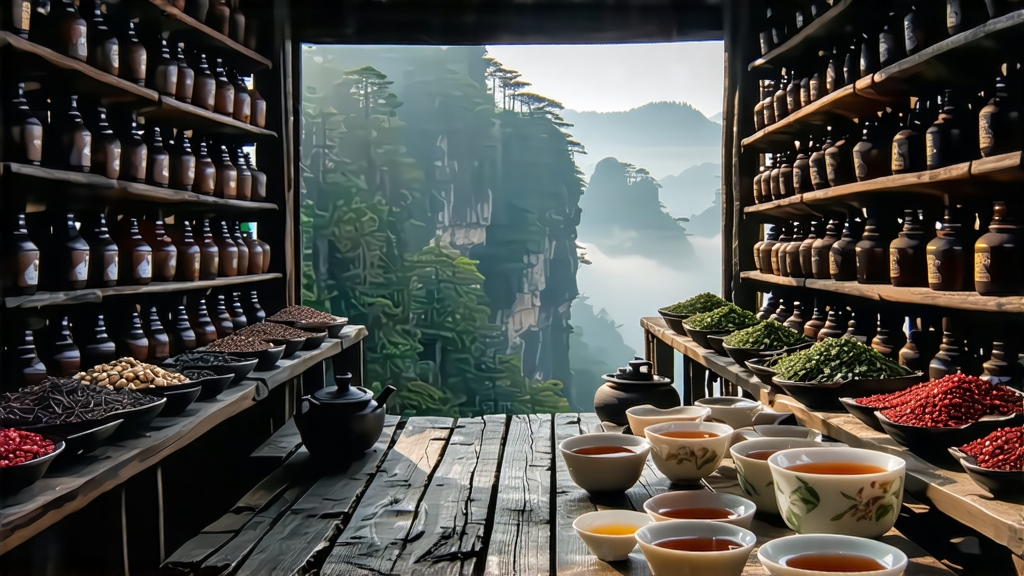
Long before Assam, Ceylon or Earl Grey filled European cups, the first black tea ever created was born in the rugged Wuyi Mountains of northern Fujian. Locals call it Zheng Shan Xiao Zhong—“proper-mountain small-leaf variety”—but the trading houses of old Canton anglicised it into the musical name we know today: Lapsang Souchong. To international drinkers the tea is famous for its heady pine-smoke, yet behind that fragrance lies a 400-year story of military urgency, maritime trade, and the moment when China taught the world what fully oxidised leaf could taste like.
History: From Ming-Era Flight to London Drawing Rooms
Legend places the birth of Lapsang Souchong in 1646, when Qing troops pressed southward through Fujian. Retreating Ming soldiers camped amid tea factories in the village of Tongmu, delaying the spring harvest. To dry the late leaf quickly before it spoiled, workers dried it over open pinewood fires. The accidental smoke infusion proved wildly popular with Dutch and British buyers at the port of Xiamen, and by the late 1600s “bohea” (the Fujianese pronunciation of “Wuyi”) dominated the ledgers of the East India Company. Samuel Pepys mentions “a cup of China drink” in 1660; a decade later Catherine of Braganza made black tea fashionable at the English court, and the smoky Tongmu original was the prototype. Thus Lapsang Souchong is not merely a style—it is the primordial black tea.
Terroir: Why Only Tongmu Can Birth the Authentic Leaf
The Wuyi range is a UNESCO World Heritage labyrinth of narrow gorges, humid cloud cover, and mineral-rich lateritic soil. Within the core 60 km² reserve lies Tongmu Guan, a village reachable only by footbridge and stone path. Here, the Xingcun Xiaozhong cultivar—an indigenous small-leaf camellia—thrives between 600 m and 1,200 m, shrouded in morning mist that moderates ultraviolet light and concentrates amino acids. Night temperatures drop sharply, forcing the plant to produce more fragrant terpenes; the same resinous pinus massoniana that perfumes the air provides the smoking fuel. Move the bush a single valley outward and the chemistry changes: the tea may still be pleasant, but it will never display the sweet resinous balance that defines true Zheng Shan.
Grades & Styles: Smoke, No Smoke, and Everything Between
- Traditional Song Zhong (Pine-Smoked): The original. After withering, leaves are pan-fired, rolled, then laid on bamboo trays above a pinewood ember pit. Fresh resinous logs are added hourly so the smoke curls upward for 8–10 h. The finished tea carries a campfire sweetness that lingers on the palate like aged mezcal.
- Unsmoked Xiao Zhong (Zheng Shan Xiao Zhong “Original”): Since 2005 an increasingly popular “clean” version omits smoking to showcase the honeyed, longan-fruit character intrinsic to the leaf. It is this style that won gold at the 2010 World Tea Championship and converted many purists who had dismissed Lapsang as merely “liquid bacon.”
- Wuyi Gongfu Cut: A broken-leaf grade designed for Russian samovars, stronger and faster-infusing, still lightly smoked but with more malt.
- Special Finishes: Tea masters now experiment with apple-wood, cedar, even lychee-wood smoke, but only pinewood from Tongmu is permitted under the 2012 Fujian Geographical Indication law for the label “Zheng Shan.”
Craft: Eight Steps That Turn Green Leaf into Smoky Velvet
- Picking: One bud plus two leaves, plucked between Qingming and Guyu when saponins are low and sugars peak.
- Withering: Leaves are spread 3 cm deep on bamboo screens in the upper loft of the three-storey wooden factory. Night mountain air reduces moisture from 75 % to 60 % over 10 h; no fans are used, only cross-ventilation through latticed walls.
- Rolling: A 25-minute gentle roll on 19th-century cast-iron tables bruises cells enough to initiate oxidation without breaking the leaf surface; this preserves the smooth mouthfeel.
- Oxidation